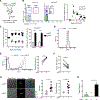Cytomegalovirus Infection Drives Avidity Selection of Natural Killer Cells
- PMID: 31103381
- PMCID: PMC6614060
- DOI: 10.1016/j.immuni.2019.04.009
Cytomegalovirus Infection Drives Avidity Selection of Natural Killer Cells
Abstract
The process of affinity maturation, whereby T and B cells bearing antigen receptors with optimal affinity to the relevant antigen undergo preferential expansion, is a key feature of adaptive immunity. Natural killer (NK) cells are innate lymphocytes capable of "adaptive" responses after cytomegalovirus (CMV) infection. However, whether NK cells are similarly selected on the basis of their avidity for cognate ligand is unknown. Here, we showed that NK cells with the highest avidity for the mouse CMV glycoprotein m157 were preferentially selected to expand and comprise the memory NK cell pool, whereas low-avidity NK cells possessed greater capacity for interferon-γ (IFN-γ) production. Moreover, we provide evidence for avidity selection occurring in human NK cells during human CMV infection. These results delineate how heterogeneity in NK cell avidity diversifies NK cell effector function during antiviral immunity, and how avidity selection might serve to produce the most potent memory NK cells.
Keywords: NK cells; cytomegalovirus; heterogeneity; selection; viral infection.
Copyright © 2019 Elsevier Inc. All rights reserved.
Conflict of interest statement
Declaration of Interests
The authors declare no competing interests.
Figures




Comment in
-
Distinct Surface Expression of Activating Receptor Ly49H Drives Differential Expansion of NK Cell Clones upon Murine Cytomegalovirus Infection.Immunity. 2019 Jun 18;50(6):1391-1400.e4. doi: 10.1016/j.immuni.2019.04.015. Epub 2019 May 15. Immunity. 2019. PMID: 31103380
-
The Avidity Game: Selecting Natural-Born Killers.Immunity. 2019 Jun 18;50(6):1337-1339. doi: 10.1016/j.immuni.2019.05.018. Immunity. 2019. PMID: 31216454
References
-
- Aguilar OA, Berry R, Rahim MM, Reichel JJ, Popović B, Tanaka M, Fu Z, Balaji GR, Lau TN, Tu MM, et al. (2017). A viral immunoevasin controls innate immunity by targeting the prototypical natural killer cell receptor family. Cell 169, 58–71. - PubMed
-
- Arase H, Mocarski ES, Campbell AE, Hill AB, and Lanier LL (2002). Direct recognition of cytomegalovirus by activating and inhibitory NK cell receptors. Science 296, 1323–1326. - PubMed
-
- Biron CA, Byron KS, and Sullivan JL (1989). Severe herpesvirus infections in an adolescent without natural killer cells. N. Engl. J. Med 320, 1731–1735. - PubMed
Publication types
MeSH terms
Substances
Grants and funding
LinkOut - more resources
Full Text Sources
Other Literature Sources
Medical
Molecular Biology Databases

